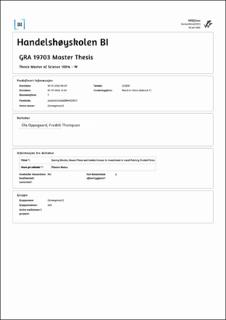Saving Shocks, House Prices and Limited Access to Investment in Local Publicly Traded Firms
Master thesis
Permanent lenke
https://hdl.handle.net/11250/3039379Utgivelsesdato
2022Metadata
Vis full innførselSamlinger
- Master of Science [1621]
Sammendrag
In this thesis, we examine the relationship between stock market investment and real
estate investment, with roots in the Home bias theory. We explore in detail, the
connection between house price growth in states and areas defined by 3-digit zip-codes in
the U.S. and the number of local publicly traded firms. Our thesis uses the Covid-19
pandemic induced saving shock and demonstrates how house prices in areas with a high
number of local publicly traded firms tend to rise less compared to house prices in areas
with a low number of local publicly traded firms.
In our analysis, we utilise quarterly panel data for both states and areas defined
by 3-digit zip-codes, and use a binary- and continuous treatment difference-in-differences
model. First, we find a negative relationship between changes in house prices and the
number of local publicly traded firms. These findings are in line with existing literature
and supports our hypotheses. We also find that the saving shock during the Covid-19
pandemic led to a higher difference in house price growth between zip codes with a
high/above median number of headquarters and the low/below headquartered ZIPs.
There are mild pre-trends in the data, suggesting our findings may be influenced by
pre-existing trends. However, on a general basis we observe a stronger effect after the
Covid-19 shock than the pre-trends suggest which supports an increased effect in the
savings shock period.
Beskrivelse
Masteroppgave(MSc) in Master of Science in Business, Finance - Handelshøyskolen BI, 2022
